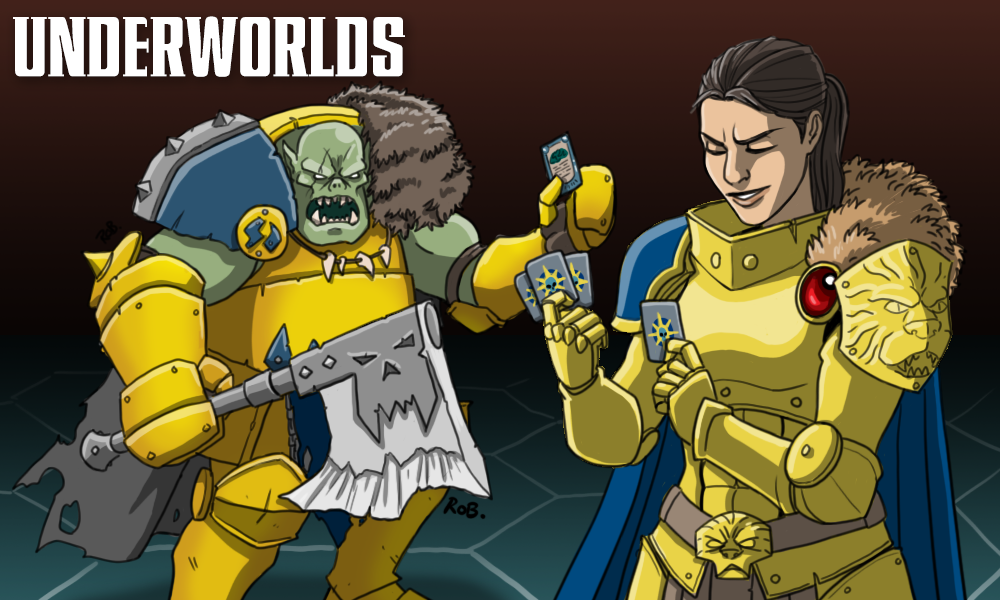Glory Hunting is a semi-regular series aimed at helping you play Warhammer Underworlds! Check out our previous coverage here.
“For every action, there is a reaction. But only one, unless it’s a reaction action, but not if it’s an activation action just a regular action. I think.” – Rippa Narkbad’s Third Law of Action
By far the most common questions I’ve seen in various Warhammer Underworlds communities are about actions, reactions, and activations. Taken individually they’re fairly simple concepts and easy to understand. It’s in the details of Reaction timing and rules where things get complicated. On this installment of Glory Hunting, I’ll break down how it works and show you how you can leverage the Reaction rules to ruin your opponent’s plans. First, let’s get some get some descriptions down.
Activations

Activations are the heartbeat of Warhammer Underworlds. The game is divided into 3 rounds, each containing an Action Phase. This is where the excitement happens. Each player is given 4 Activations per round with which to victory. It’s important to note that an Activation is not something performed; an Activation represents your opportunity to take Actions. In short, your Activation is your Turn.
When you take an Activation, you become the Active Player. At this point you can perform 1 or more Actions. Once they’re resolved, the Activation ends and the Power Step begins. When that’s done, your opponent’s Activation will begin. While most of the time you won’t need to think about the particulars, it’s important to understand the concept because of the increasing number of Reactions in the game.
Actions

Actions are the things you or your fighters do within the game. Note, the glossary definition is incomplete. Actions are divided into two categories: Player Actions and Fighter Actions. Player Actions are things like Drawing Power Cards or Objective Cards and Fighter Actions are things like Move, Attack, Guard, etc. There are Actions common to all fighters, Actions printed on Fighter Cards unique to that fighter, and Actions provided by Upgrade cards.
The majority of Activations in any game of Underworlds will only contain a single Action, however there are some critical exceptions. The Charge action consists of a Move Action followed by an Attack Action with the restriction that the Move Action most end with the fighter capable of performing an attack. Attack Actions with the “Scything” keyword consist of multiple Attack Actions each carried out in sequence against some or all eligible targets.
Any time a single action is made up of multiple actions, it is known as a Superaction. Superactions have some specific rules, most notably that Inspiration Conditions met in the middle of a Superaction do not resolve until the end of the entire Superaction. It’s worth noting that a Superaction is an action that itself creates multiple actions. If a Reaction to an Action generates another Action, this is not considered a Superaction.
Reactions

Reactions have become a huge part of Warhammer Underworlds because they give you the opportunity to act out of turn. In a game with only 12 Activations, access to bonus actions or bonus effects is huge so it’s important to know how to leverage Reactions. Reactions come in many forms. Some provide an additional Action executed the same you you’d execute any normal action, and others provide non-Action effects like a Push or Card Draw. It may seem like I’m picking nits, but these distinctions matter heavily when we start putting things together.
All Reactions are composed of two parts. The first is the Condition that must be met before you can use the Reaction, and the other is the timing window in which the Reaction occurs. If multiple players want to play a Reaction in a timing window, the player who is not the Active Player gets the first opportunity. Additionally – and this is the most important rule about Reactions – only 1 Reaction may be played per Timing Window. This is very important as many cards with different conditions share the same timing window.
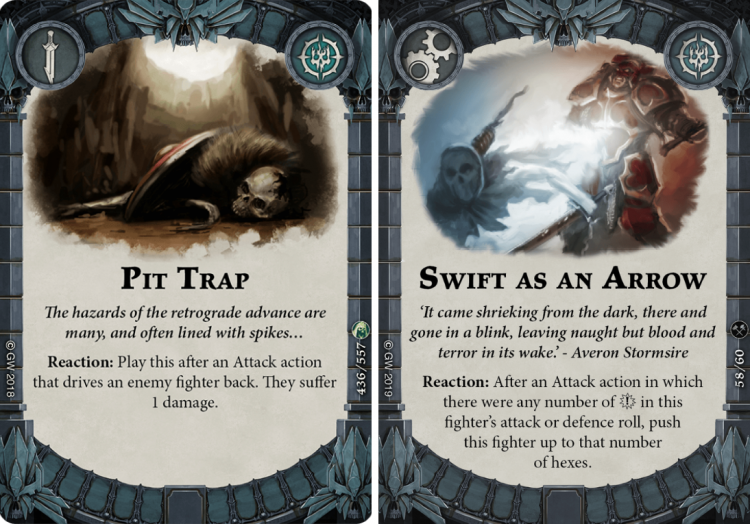
These two cards share a timing window, but have different conditions and different effects. The Timing Window for both of these is “After an Attack action”. The condition for Pit Trap is “an Attack Action that drives an enemy fighter back” and the condition for Swift as an Arrow is “an Attack action in which there were any number of [Crit Symbols] in this fighter’s attack or defense roll” (this refers to the fighter with the upgrade). Because the two cards share a timing window, only 1 of them can be played even if the condition for both is met.
Now that we have the definitions down, let’s explore some examples of how you can use Reactions to foil your opponent’s plans with some common examples.
Timing Window Conflict
Pit Trap and Swift as an Arrow share a timing window, which means only one can be played per attack. If you’re the attacker and have both of these Reactions available to you you may have the tough choice between dealing extra damage or getting some free movement, assuming you rolled some crits in your attack.
However, if you’re the Defender in this situation you can use Swift as an Arrow defensively. Pit Trap is a very common card, particularly in aggressive decks. Until you see it, you almost have to assume your opponent has it. A card like Swift as an Arrow can give you some added insurance. If you are the Defender and your Swift as an Arrow equipped fighter is attacked and you roll a Crit in the defense, you can block your opponent’s use of Pit Trap by declaring that you would like to React to the attack with Swift as an Arrow. Because the Defender is the non-Active Player when being Attacked, the Defender has priority during all Reaction Timing Windows. Even if you don’t need to move, you may activate it just to prevent Pit Trap from firing. It could save a fighters life.
After an Activation
One of the most baffling and frustrating rulings in all of Underworlds came via an FAQ clarification.

Reactions that occur After an Activation share a timing window with reactions that occur After an Action, if and only if that Action is the last action of the Activation. I’m a bit baffled as to why they made this ruling, as it is not intuitive and creates a lot of frustrating situations.
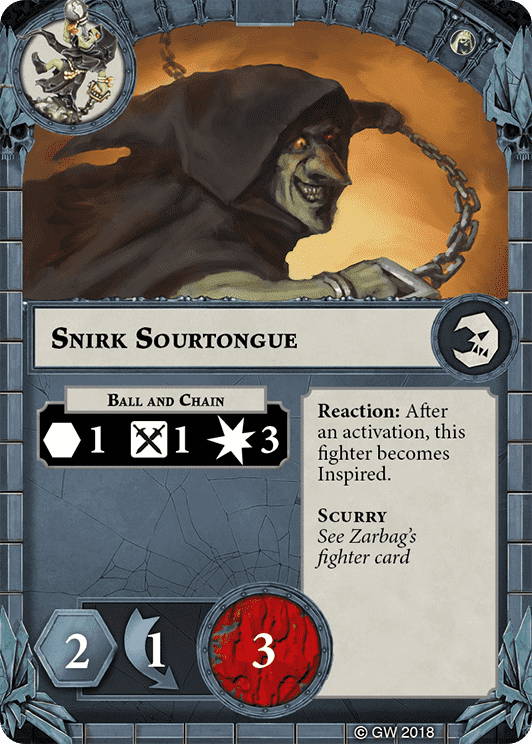
Snirk Sourtongue is a fighter in the Zarbag’s Gitz warband, with an interesting inspire condition. As a Reaction, you can choose to flip him to his inspired side after any activation. The ruling above makes it clear that this Reaction can be blocked via “After an Action” effects as well as other “After an Activation” effects. It also means that you can’t Inspire Snirk in the same activation in which you play a card like Pit Trap
However, because the FAQ makes clear that the conflict only occurs for the last Action in an activation, you can use Pit Trap during a Scything attack so long as you make another attack after using it. If you play this game long enough, either your plans or your opponent’s plans will be foiled by this FAQ ruling.
Best Laid Plans
Armed with the details about Reactions and Actions, you can now start to use cards defensively. Recognizing which cards shut off Pit Trap can help you live a little longer against an aggressive warband. An inspired Snirk is harder to kill and you can block them from Inspiring after one of their own turns if you have access to the right effects. Before I close this article, let’s take a look at a particularly frustrating card.
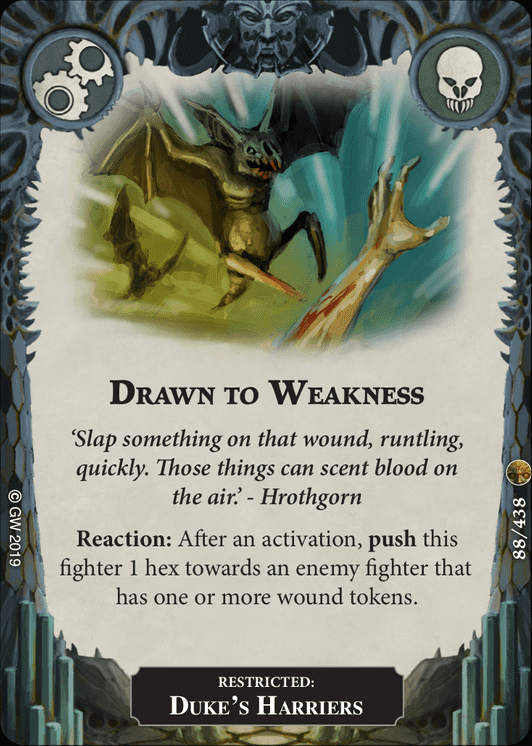
Drawn to Weakness belongs to the Grymwatch. It is attached to your hunting bats and gives them quite a bit of free movement over the course of the game. You can use it after any activation – yours or your opponent’s – meaning it can be used to shut down a number of your opponent’s cards. No Pit Trap while this is out, no Spark of Sentience for Mollog, no Soul Drain, no Blessing of Hydragos. Perhaps most annoyingly, no Snarlfang Attacks.
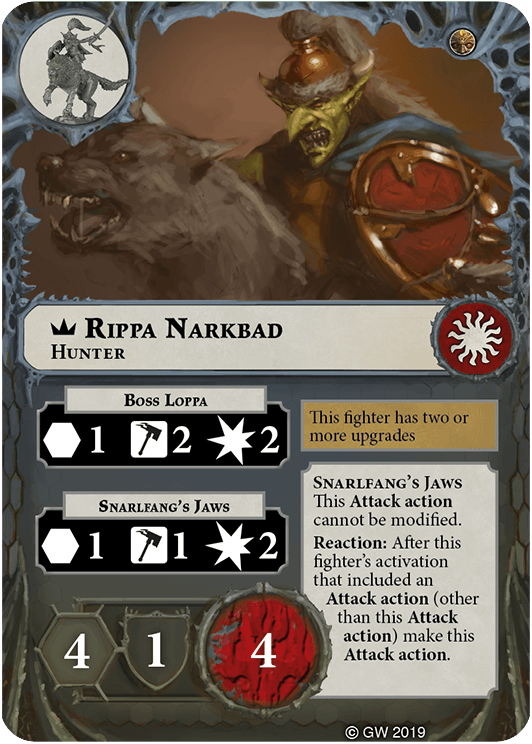
Drawn to Weakness shuts down quite a few cards in general, but completely shuts down a major part of the Snarlfang warband. Since they share a Reaction window, so long as one these doggo riding gobbos is hurt you can bounce your bats around the board preventing the wolves from ever taking a bite of your ghouls.
Underworlds is full of Reaction effects and we can surely expect to see more. They’re a great way to add new effects and flavor to warbands. They can also be used creatively to prevent your opponent from piling on the damage or fully executing their plan. Correct usage of reactions can make a big difference in who wins and loses.
Got any questions or feedback for us? Drop us a note in the comments below or email us at contact@goonhammer.com.
